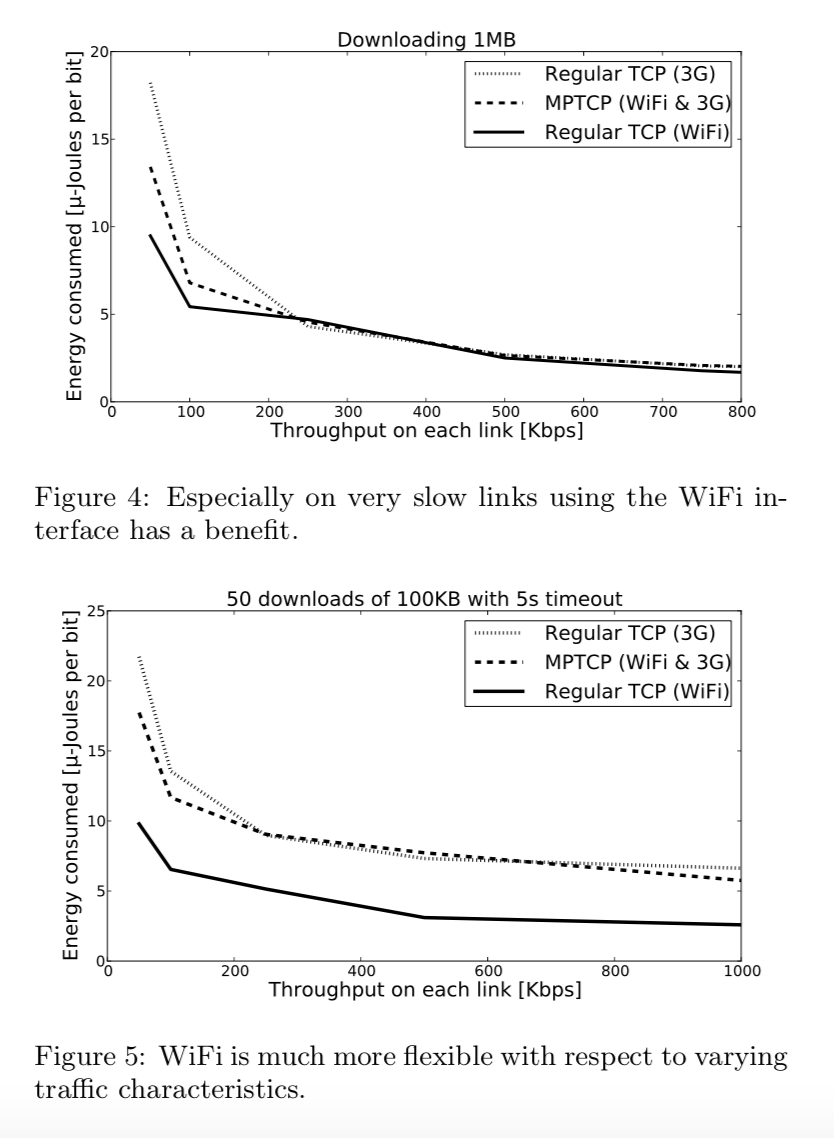The first Multipath TCP enabled smartphones
Smartphones are a very important use case for Multipath TCP with two very large scale deployments :
- Apple uses Multipath TCP on iPhones and iPads. In 2013, the initial motivation was to support fast handovers for the Siri voice recognition application. Since iOS12, any iOS application can use Multipath TCP
- High-end Samsung and LG samrtphones in South Korea use Multipath TCP to bond their Wi-Fi and cellular interface for the GigaLTE service to reach a bandwidth of up to 1 Gbps.
Although the designers of Multipath TCP were aware of the importance of the smartphones, the initial focus of the design was to enable ressource pooling. A first analysis of the benefits that Multipath TCP appeared in [RNBH11] with experiments carried out with a userspace implementation running on laptops.
The initial support for Multipath TCP on smartphones started with interactions with the engineers of a young Irish company called Multipath Networks. They had developed a first prototype that bonds several access networks together by using Multipath TCP. To cover new use cases, such as in-vehicle data transfers, they were testing the ability of Multipath TCP to quickly recover from the failure of any network interface. At that time, Multipath TCP was mainly used on servers and laptops and this part of the code was not heavily tested. Thanks to their detailed tests, we could improve the Multipath TCP implementation in the Linux kernel to better react to link failures.
When a smartphone moves, it may switch frequently from one access network to another. We explore these failures in more details in [PDD+12] by leveraging the recent updates to the Linux implementation. A key result of this paper was to demonstrate that Multipath TCP can provide fast handovers as shown in the figure below.

Our measurements indicated that the application could take up to 3 seconds to recover from a network failure with TCP. For Multipath TCP, we proposed two different modes of operation: Full MPTCP and the Backup Mode. With Full MPTCP, the two subflows are used simultaneously while the Backup Mode use the MP_PRIO option to indicate that a subflow should only be used once the other subflow fails.
This paper was also the first to describe measurements with Multipath TCP on a real smartphone: the Nokia N950.

It was mainly used to study the energy consumption of the cellular and Wi-Fi interfaces when using Multipath TCP.

Unfortunately, this developper phone never became widely used. We then performed some experiments with Samsung Galaxy S2 smartphones and we obtained later a dozen of Nexus5. The Samsung Galaxy S2 was used to record a nice video that demonstrates how Multipath TCP enables smooth handovers.
The video shows two live video streamings. The smartphone uses a Wi-Fi hotspot provided by a laptop that captures packets on its Wi-Fi interface and displays them on the right part of the screen. With regular TCP, the video stream stops when the smartphone leaves the area covered by the Wi-Fi access point. With Multipath TCP, the video stream switches automatically to the cellular interface and then later comes back to the Wi-Fi when the user returns.
Several researchers have explored the performance of the Linux Multipath TCP on smartphones. De Coninck et al. have configured a set of Nexus devices to use a SOCKS proxy [CBHB16a]. This is similar to the Giga LTE deployment mentioned earlier, but at a much smaller scale. This analysis captured 71 millions packets over more than 7 weeks. Using the same devices, the same team of researchers analysed the behavior of the most popular smartphone applications over Multipath TCP [CBHB16b]. A similar study was published in [NGQ+16]. Later, De Coninck proposed several improvements to the Multipath TCP implementation to tune it for interactive applications running on smartphones [CB18].
As of December 2018, there is no published detailed analysis of the performance of Multipath TCP on iPhones, despite the large user base. We’d be very interesting in collecting packet traces on servers that are used by iPhone applications that have enabled Multipath TCP. Feel free to contact me if you have deployed such an application.
References
| [CBHB16a] | Quentin De Coninck, Matthieu Baerts, Benjamin Hesmans, and Olivier Bonaventure. A first analysis of multipath tcp on smartphones. In 17th International Passive and Active Measurements Conference, volume 17. Springer, March-April 2016. URL: https://inl.info.ucl.ac.be/publications/first-analysis-multipath-tcp-smartphones.html. |
| [CBHB16b] | Quentin De Coninck, Matthieu Baerts, Benjamin Hesmans, and Olivier Bonaventure. Observing real smartphone applications over multipath tcp. IEEE Communications Magazine, Network Testing Series, March 2016. URL: https://inl.info.ucl.ac.be/publications/observing-real-smartphone-applications-over-multipath-tcp.html. |
| [CB18] | Quentin De Coninck and Olivier Bonaventure. Tuning multipath tcp for interactive applications on smartphones. In IFIP Networking 2018. 2018. URL: https://inl.info.ucl.ac.be/publications/tuning-multipath-tcp-interactive-applications-smartphones.html. |
| [NGQ+16] | Ashkan Nikravesh, Yihua Guo, Feng Qian, Z Morley Mao, and Subhabrata Sen. An in-depth understanding of multipath tcp on mobile devices: measurement and system design. In Proceedings of the 22nd Annual International Conference on Mobile Computing and Networking, 189–201. ACM, 2016. |
| [PDD+12] | C. Paasch, G. Detal, F. Duchene, C. Raiciu, and O. Bonaventure. Exploring Mobile/WiFi Handover with Multipath TCP. In Proceedings of the 2012 ACM SIGCOMM workshop on Cellular Networks: Operations, Challenges, and Future Design (CellNet). 2012. URL: https://inl.info.ucl.ac.be/publications/exploring-mobilewifi-handover-multipath-tcp.html. |
| [RNBH11] | Costin Raiciu, Dragos Niculescu, Marcelo Bagnulo, and Mark James Handley. Opportunistic mobility with multipath tcp. In Proceedings of the sixth international workshop on MobiArch, 7–12. ACM, 2011. |